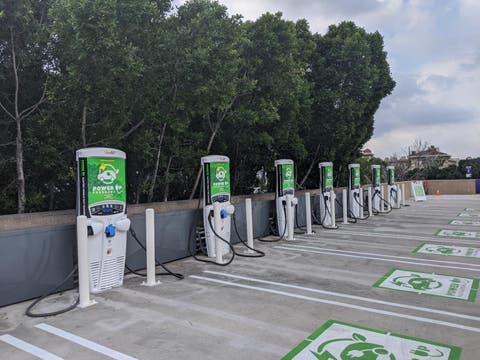
Installing electric car charging stations can be expensive. They can cost from a few hundreds to five or six thousands dollars depending on the location and how many charging stations you have, as well as the electrical power of the site. However, these are a worthwhile investment in the long run. They can enhance the parking lot's value, make the life of electric vehicle owners easier, and may increase footfall to shopping centers and leisure facilities.
The biggest cost factor is often the labor required to install a charging dock. The hourly rate for an electrician can be between $40 and $100. A 240-volt circuit with 50-amp outlet could cost $300 to $800. If you have an older property, it may be necessary to upgrade or purchase a new circuit breaker.
The cost for an EV charging station depends on the type of vehicle. There are many brands of chargers, including those from Bosch and Siemens. The Bosch model comes with a hardwire and can cost $450 to $1360. While the Siemens model has a wi-fi capability and can be purchased for $340 to $760.

Some models provide free charging for a set period. Some EV charging vendors offer a revenue share model. This allows the business to keep a small share of the revenue generated by the charging station but will mean that the station is no longer owned by the owner.
Public charging stations can vary in price, but many charge a flat fee or per kilowatt-hour rate. Many offer memberships which can help reduce costs. There are apps that will help EV drivers locate charging points in their region. PlugShare, a well-known app, can find charging stations that are open to the general public.
A Level 3 charging station also known as DC Fast Charging Stations can recharge half the battery of an EV in 30 minutes. These are typically more expensive than Level 2 chargers. Installing a Level 2 charger is an option if the cost of installing a Level3 charging station is prohibitive. It will save you money over the long-term by charging your electric vehicle at your home.
Before you spend money on an EV charging system, make sure to check if your property is eligible for rebates. Some utilities offer rebates to cover the cost of an electrical permit or other project costs. A wi-fi enabled charger may also be eligible for additional rebates. It is a good idea plan carefully and hire an electrician to complete the installation.

Installation of an EV charging station takes as little as twenty hours. It might take two to three days for larger projects. A clear scope of work will help you keep your budget in line with your goals.
Additional to installing the device, you will also need to purchase accessories and a charging cable. These can include a cable organizer, pedestal mount, and a Wi-Fi booster.
FAQ
What is the average time it takes to become a mechanic?
To become a skilled mechanic, you need years of experience and practice. You can learn the most effective way to fix cars by learning from a professional mechanic.
You will spend time in a workshop learning everything you can about cars. You will need to be familiar with mechanical engineering books about mechanics, car design, and other topics.
And you'll also need to attend auto school.
The most important thing is to start early. To learn about automotive technology, don't wait to be older. Get started now if you are interested in becoming a mechanic.
Is being an auto mechanic a promising career choice?
For those who are passionate about excellence, automotive is a rewarding industry. It is important to work hard and learn as much from others as you can in order to succeed in this industry.
Excellent communication skills are essential as you will spend most of the time speaking to customers or other employees. You will need to be able and willing travel for work, making it more difficult to commute.
You can take classes at universities and community colleges if you are interested in a career as an automotive technician. Many schools have programs that are specifically tailored for students who are interested in automotive sales, repair, and customer service.
Studying mechanical engineering is an option if you're interested in pursuing a degree. You can earn a bachelor's in as little four years.
Many employers will hire graduates straight out from school. You should start looking for employment as soon as you are able to continue your studies part-time.
Once you've completed your education, you'll probably need to complete some form of training before being able to take up a position as an automotive technician.
This means you'll need pass exams like the Automotive Services Excellence (ASE), certification exam. This test covers topics including engine maintenance, brakes, steering systems, suspension, and more.
Once you've passed the ASE test, you can apply for a license issued by the National Institute for Automotive Service Excellence.
You can repair vehicles owned by private citizens with a license. In exchange, you'll receive compensation based on the number of services performed.
It's important to note that not all states require licensing. If you intend to work in another state, however, you will need a license.
Some states won't issue licenses until you have completed a certain amount training. This could be you.
Is being a mechanic apprentice hard?
It's not easy, but you learn fast, and there are many opportunities for advancement.
You must be patient and persistent. You should also be able to repair cars, trucks, and motorbikes.
There is a lot of pressure from customers and family members who want you to succeed. But, you shouldn’t be pressured to make any decisions you aren’t happy with.
This could be an excellent career choice for someone who enjoys fixing cars. This job allows you to make a decent wage and build up your company.
Perhaps you prefer a different route. If this is the case, you might want to become a technician.
This involves using your technical expertise to support other workers. You could help technicians troubleshoot problems or teach them new techniques.
Another option is to be a service advisor. Here, you'll provide advice and assistance to customers when they bring their cars to a garage.
Your decision will be based on what your priorities are. There are plenty of options available, and you can choose which suits you best.
Is it difficult to find a job as a mechanic in the automotive industry?
Yes, it's possible. Many garages post their vacancies online. Many people apply simply because they think it might make them feel good. You can apply for several places to see if they are accepting student applications if you want to get your foot in their door. If you don't know anyone working in the industry, ask your friends and relatives. They may be happy and willing to recommend someone.
How long is an apprenticeship for an automotive mechanic?
The apprenticeship to become an automotive mechanic takes about three years. This includes two year at school as well as two years as an apprenticeship. The first year is dedicated to learning the theory and practical skills of the trade. During this time, you'll also learn how to use tools safely and efficiently. You'll spend the second year in on-the-job training, where you will gain experience in various trades. These years will offer you the opportunity to attend formal classes.
The last year of your program will be spent earning qualifications and becoming certified. These include NVQs. They are awarded after passing exams on specific topics within the industry. Additionally, HNCs are Higher National Certificates that cover general subjects such management, customer service, and business administration. City & Guilds certificates can be obtained for individuals who want to learn certain trades.
What is the difference in a mechanic and an auto technician?
Both are related, but they are not the same. An automotive technician maintains cars, while a mechanic repairs them.
A mechanic must possess good manual dexterity, and be able perform simple tasks efficiently. They should also be able correctly diagnose and repair any problems.
An automotive technician requires more technical skills than a mechanic. They need to be able use tools such drills and wrenches, and read blueprints.
They should also be capable of safely performing complex procedures. They must also be familiar with different types of engines and electrical systems.
They must also be able comprehend how the various parts interrelate with one another.
As a result, a mechanic usually earns less money than an automotive technician. Both jobs offer many possibilities.
Statistics
- There were 749,900 jobs available for automotive service technicians and mechanics in 2016, which is expected to grow by six percent through 2026. (jobhero.com)
- The U.S. Bureau of Labor Statistics (BLS) reports that the job outlook for automotive service technicians and mechanics is expected to decline by 4% from 2019 to 2029. (indeed.com)
- Apprentice mechanics earn significantly less hourly than mechanics who have completed training, with a median wage of approximately $14.50 an hour, according to PayScale. (jobhero.com)
External Links
How To
How to correctly diagnose your vehicle for repairs
First, look at the symptoms of your car to determine if it needs repair. Next, you can follow these steps in order to diagnose your car.
-
Check engine lights. You should inspect the dashboard lights, such as the engine light indicator and the oil pressure gauge. Also, check the battery light indicator. If they have been flashing for more days than usual, it could be a sign that something is wrong with the vehicle.
-
Take a look at the treads. Tire wear can lead to problems in handling and brake performance. You should also inspect the wheel treads. You should ensure that they are clean and smooth. The best way to do this is to remove the wheels and take them off. A flashlight can be used to check how worn the treads are.
-
Monitor the level and consistency of your brake fluid. You must always monitor the level of your brake fluid. This helps ensure that your brakes operate properly. Low brake fluid levels can cause brake failure when you apply pressure.
-
You should test the suspension system. A suspension system is designed to absorb vibrations and shocks. This suspension system provides greater control and smoother acceleration and deceleration. You might notice a wobbly feeling or uncontrollable shaking in your vehicle if it has a problem with its suspension. To determine whether your vehicle may have a suspension issue, you can try to put weight on the rear or front axle and watch the movement.
-
Examine the steering column. The steering column is used to link the steering wheel with the rest of vehicle's components. Steering columns can be damaged by accidents. Replace it if your steering column feels loose or unsteady.
-
Observe the exhaust pipe. Exhaust pipes help move gases from the combustion chamber to the atmosphere. If the exhaust pipe is damaged or leaks, harmful fumes can enter your cabin. Additionally, your tailpipe should be fixed immediately if it is bent.
-
Take a look under your hood. Take a look underneath the hood to find any strange or unusual items. Your engine could be leaking fluids. A professional technician should be contacted if your engine compartment emits an unusual smell.
-
It is important to inspect the air filter. The vehicle's outside environment may cause the air filter to collect dust and debris. A dirty filter can lead to a poor vehicle's performance. Replace your air filter regularly.
-
Check the fan belt. The fan belt is the link between the engine and the transmission. If the fan belt fails, the engine won't start. It is very easy to replace your belt. All you need are a screwdriver & pliers.
-
You should inspect the radiator and hoses. The radiator hose transports water from radiator to engine. If it becomes cracked or damaged, it can leak hot liquid onto the engine. Repairing the hose is easy with a pair of needlenose pliers or a small wire brush.
-
Be sure to inspect your windshield wipers. Windshield wipers use electricity for snow and rain removal. If they stop functioning, they can leave streaks in your window glass. Simply change the washer oil to fix the problem.
-
The battery cables should be checked. Your car's electrical system is powered by batteries. Always disconnect the negative wire before you replace batteries. Failure to do so can damage your alternator.
-
Make sure your headlights are working properly. Headlights are used to illuminate the road ahead. It can lead to poor visibility if they aren't working properly. You can check the bulbs to make sure they aren't burned out.
-
Be sure to check the lights. The lights are there to warn other drivers if they approach you at night. If one doesn't work, it could distract you and lead to an accident.
-
Check the brakes. Before you get in a car accident, your brakes will be slowing down your vehicle. If the brakes fail to work correctly, your car could lose control and collide with another vehicle.
-
Change the oil. The oil keeps your engine well lubricated. It protects metal parts and prevents them from wearing too quickly. Changing the oil every month is recommended.